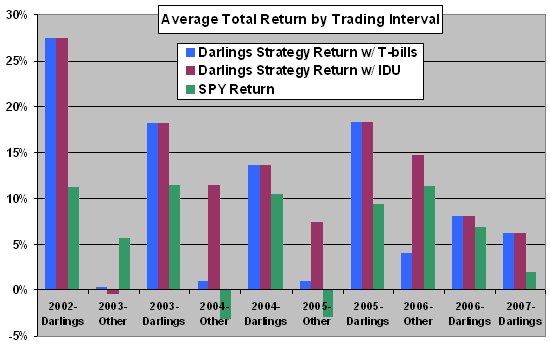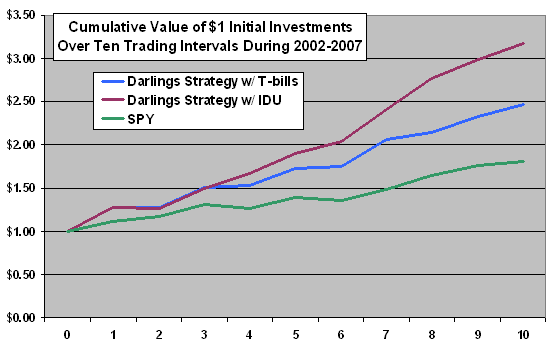A reader asked:
“Have you tested the Darlings of the Dow strategy developed by Larry Williams? He has modified his original strategy several times, and I wonder whether he made revisions because of new insight or because the original strategy proved not much better than the five cheapest Dogs of the Dow. What I find interesting is his timing of the Darlings with Sy Harding’s MACD timing method and his buying the Dow Jones Utilities for the remainder of the year.”
The original Darlings of the Dow strategy employs fundamentals to select the five most undervalued stocks in the Dow Jones Industrials Average and times entries and exits seasonally (enter in October and exit in April). The revised version chooses other entry and exit dates. To evaluate the strategy, we assume that the trading dates/returns for Darlings of the Dow stocks are as listed by Larry Williams and that returns while out of the Darlings are the adjusted returns for the iShares Dow Jones US Utilities (IDU). As benchmarks, we calculate returns based on adjusted closing values for S&P Depository Receipts (SPY) over the same intervals and average 90-day Treasury bill (T-bill) yields as an alternative to IDU returns. We use a test period of 2002-2007 (10/28/02-9/13/07) that is out-of-sample and post-publication with respect to the original strategy. We find that:
The following chart summarizes returns by trade for two Darlings of the Dow strategies (one that is in T-bills and one that is in IDU when out of the Darlings) and for SPY over the ten trading intervals in the sample period. Results exclude trading frictions. Note that:
- The Darlings of the Dow strategy that alternates Darlings with T-bills generates an average return per trade of 9.8% with standard deviation 9.2%. It beats SPY in eight out of ten trading intervals.
- The Darlings of the Dow strategy that alternates Darlings with IDU generates an average return per trade of 12.5% with standard deviation 7.8%. It beats SPY in nine out of ten trading intervals.
- SPY generates an average return per trade of 6.2% with standard deviation 5.7%.
- A sample of ten trading intervals is small.
How do these trades translate into cumulative returns?

The next chart shows the cumulative value of $1 initial investments in the two Darlings of the Dow strategies and in SPY over the ten trading intervals in the sample period (without intra-trade variations). The terminal values for the three alternatives are: $2.46 for the Darlings of the Dow strategy that alternates Darlings with T-bills; $3.17 for the Darlings of the Dow strategy that alternates Darlings with IDU; and, $1.80 for SPY.
What could be misleading about these results?

Some cautions about these results are:
- As noted above, a sample of ten trading intervals is small, such that one dramatically different additional observation could substantially alter conclusions.
- There may be data snooping bias in the construction of the original Darlings of the Dow strategy, such that its historical returns involve a significant amount of luck unlikely to carry forward into out-of-sample results.
- Adjusting the strategy after original development defeats out-of-sample testing and elevates the level of data mining bias. We cannot confidently test the original Darlings of the Dow strategy because the Darlings at the end of October may be different from the Darlings chosen on some other date.
In summary, the Darlings of the Dow strategy offered solid returns over the short post-publication period of 2002-2007, but the level of data mining bias in these returns is unknown and strategy adjustments have impaired out-of-sample testing.